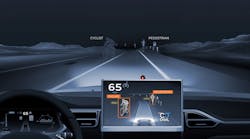New Regulations for Cars Protect Pedestrians at Night
Government NCAP Regulations:
How to Protect Pedestrians at Night
A recent report from the Insurance Institute for Highway Safety (IIHS) reached an alarming conclusion. Not only have pedestrian injuries and deaths been rising for years but the systems now installed on automobiles intended to protect pedestrians fail to work at night when more than 76% of the fatalities occur. This realization has prompted rapid changes in automobile safety test protocols and intensified the search for reliable methods of classifying pedestrians at night.
Efforts to improve pedestrian safety were underway even before the first pedestrian crossing signal was installed in England in 1868 to reduce casualties from strikes by horse-drawn carriages. For the next 130 years or so, the solutions for vehicles of all types concentrated on passive safety systems—removing impaling ornaments, adding lights and horns, and curving the outer vehicle surfaces. Only when cars got computers did the emphasis shift to active safety systems as regulators realized that perhaps the car itself could help avoid collisions.
By the late 1960s, when computers that could survive in the engine compartment became available, the use of automotive computers spread rapidly, first for fuel injection control and, 20 years later, in the first dashboard touchscreen. As far back as 1956, closed-circuit cameras were mounted on concept cars to assist in backup viewing but 35 years elapsed before the first production model appeared. Finally, in 2010, national traffic safety regulators mandated the first active system directed at pedestrian safety—backup cameras specifically intended to protect children.
To support active systems, the computers in cars became powerful enough to integrate signals from a variety of sensors so building vehicles that could operate without drivers became a feasible goal. Distance sensors using radar provided the basis for vehicle-to-vehicle anti-collision systems, raising the hope that if these sensors could accurately locate pedestrians, cyclists, and other VRUs, collisions might be reduced.
Global New Car Assessment Programs
Globally, the primary protocols for regulating the requirements for automobile configuration and performance are New Car Assessment Programs (NCAPs) established in various regions. These programs established standards for testing new vehicles with the goal of assigning safety ratings. When a new safety issue is to be addressed, a test protocol to evaluate vehicles against the requirement is added to the NCAP test suite.
Although the NCAP does not include mandates requiring specific safety measures in automobiles, the results of testing against the requirements produce a safety rating for each vehicle that can seriously impact its market success. Automobile sales statistics show a strong customer bias towards the purchase of models with the highest safety ratings. Thus, when a new requirement enters the test protocol, automobile manufacturers work diligently to assure that their vehicles will score high.
What You'll Find Inside:
The status of the latest international, automotive industry and insurance industry regulations that will change how auto manufacturers design and build their next-generation vehicles.
This new whitepaper examines the ever-changing state of these various regulations throughout the world and their impact upon what is known as PAEB (Pedestrian Emergency Braking Systems) and will specifically look at the new emerging technologies that will enable cars to essentially see at night to improve road safety for pedestrians, bicycles, motorcycles, etc.
- The failures of current systems
- The state of VRU regulations
- United States
- European Union
- Japan
- China
- Southeast Asia
- United Nations
- Why better technology is needed for night driving
- How AI can contribute to improved safety


